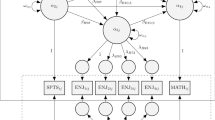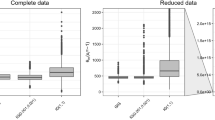Abstract
Some researchers in psychology have ordinarily relied on traditional linear models when assessing the relationship between predictor(s) and a continuous outcome, even when the assumptions of the traditional model (e.g., normality, homoscedasticity) are not satisfied. Of those who abandon the traditional linear model, some opt for robust versions of the ANOVA and regression statistics that usually focus on relationships for the typical or average case instead of trying to model relationships for the full range of relevant cases. Generalized linear models, on the other hand, model the relationships among variables using all available and relevant data and can be appropriate under certain conditions of non-normality and heteroscedasticity. In this paper, we summarize the advantages and limitations of using generalized linear models with continuous outcomes and provide two simplified examples that highlight the methodology involved in selecting, comparing, and interpreting models for positively skewed outcomes and certain heteroscedastic relationships.







Similar content being viewed by others
References
Akaike, H. (1974). A new look at the statistical model identification. Automatic Control, IEEE Transactions, 19(6), 716--723. doi:10.1109/TAC.1974.1100705.
Arpin-Cribbie, C. A., Irvine, J., & Ritvo, P. (2012). Web-based cognitive-behavioral therapy for perfectionism: a randomized controlled trial. Psychotherapy Research, 22, 194–207. doi:10.1080/10503307.2011.637242.
Barnwell, S. S., Earleywine, M., & Wilcox, R. (2006). Cannabis, motivation, and life satisfaction in an internet sample. Substance Abuse Treatment, Prevention, and Policy, 1(1), 2. doi:10.1186/1747-597X-1-2.
Blanca, M. J., Arnau, J., López-Montiel, D., Bono, R., & Bendayan, R. (2013). Skewness and kurtosis in real data samples. Methodology European Journal of Research Methods for the Behavioral and Social Sciences, 9, 78–84. doi:10.1027/1614-2241/a000057.
Blough, D. K., Madden, C. W., & Hornbrook, M. C. (1999). Modeling risk using generalized linear models. Journal of Health Economics, 18, 153–171. doi:10.1016/S0167-6296(98)00032-0.
Bonett, D. G., & Price, R. M. (2002). Statistical inference for a linear function of medians: confidence intervals, hypothesis testing, and sample size requirements. Psychological Methods, 7(3), 370. doi:10.1037/1082-989X.7.3.370.
Coxe, S., Aiken, L. S., & West, S. G. (2013). Generalized linear models. In T. Little (Ed.), Oxford handbook of quantitative methods, Vol 2: statistical analysis. New York: Oxford University Press.
Cribbie, R. A., Fiksenbaum, L., Keselman, H. J., & Wilcox, R. R. (2012). Effect of non-normality on test statistics for one-way independent groups designs. British Journal of Mathematical and Statistical Psychology, 65, 56–73. doi:10.1111/j.2044-8317.2011.02014.x.
Cui, L., Shi, G., & Oei, T. P. (2013). A study of cognitive vulnerability–stress model of depressive symptoms among Chinese adolescents. Stress and Health, 29(5), 383--391. doi:10.1002/smi.2484.
Denson, T. F., & Earleywine, M. (2006). Decreased depression in marijuana users. Addictive Behaviors, 31(4), 738--742. doi:10.1016/j.addbeh.2005.05.052.
Dick, E. J. (2004). Beyond “lognormal versus gamma”: discrimination among error distributions for generalized linear models. Fisheries Research, 70, 351–366. doi:10.1016/j.fishres.2004.08.013.
Duan, N. (1983). Smearing estimate: a nonparametric retransformation method. Journal of the American Statistical Association, 78, 605–610. doi:10.1080/01621459.1983.10478017.
Entink, R. H., Linden, W. J., & Fox, J. P. (2009). A Box–Cox normal model for response times. British Journal of Mathematical and Statistical Psychology, 62(3), 621--640. doi:10.1348/000711008X374126.
Erceg-Hurn, D. M., & Mirosevich, V. M. (2008). Modern robust statistical methods: an easy way to maximize the accuracy and power of your research. American Psychologist, 63(7), 591. doi:10.1037/0003-066X.63.7.591.
Fox, J. (2008). Applied regression analysis and generalized linear models: second edition. Thousand Oaks, CA: Sage Publications.
Gibb, B. E., Benas, J. S., Crossett, S. E., & Uhrlass, D. J. (2007). Emotional maltreatment and verbal victimization in childhood. Journal of Emotional Abuse, 7, 59–73. doi:10.1300/J135v07n02_04.
Grissom, R. J. (2000). Heterogeneity of variance in clinical data. Journal of Consulting and Clinical Psychology, 68, 155–165. doi:10.1037/0022-006X.68.1.155.
Hastie, T., & Tibshirani, R. (1986). Generalized additive models. Statistical Science, 297--310.
Hewitt, P. L., & Flett, G. L. (1991). Perfectionism in the self and social contexts: conceptualization, assessment, and association with psychopathology. Journal of Personality and Social Psychology, 60, 456–470. doi:10.1037/0022-3514.60.3.456.
Hollon, S. D., & Kendall, P. C. (1980). Cognitive self-statements in depression: development of an automatic thoughts questionnaire. Cognitive Therapy and Research, 4(4), 383--395. doi:10.1007/BF01178214.
Hosmer, D.W., & Lemeshow, S. (1995). Applied logistic regression (Second ed.). New York: John Wiley & Sons.
Hurvich, C. M., & Tsai, C. L. (1989). Regression and time series model selection in small samples. Biometrika, 76(2), 297--307. doi:10.1093/biomet/76.2.297.
Keselman, H. J., Huberty, C., Lix, L., Olejnik, S., Cribbie, R. A., Donahue, B., Kowalchuk, R. K., Lowman, L. L., Petoskey, M. D., Keselman, J. C., & Levin, J. R. (1998). Statistical practices of educational researchers: an analysis of their ANOVA, MANOVA, and ANCOVA analyses. Review of Educational Research, 68, 350–386. doi:10.3102/00346543068003350.
Keselman, H. J., Wilcox, R. R., Othman, A. R., & Fradette, K. (2002). Trimming, transforming statistics and bootstrapping: circumventing the biasing effects of heterescedasticity and nonnormality. Journal of Modern Applied Statistical Methods, 1, 288–309. Retrieved from http://digitalcommons.wayne.edu/cgi/viewcontent.cgi?article=1670&context=jmasm
Lindeberg, S. I., Eek, F., Lindbladh, E., Ostergren, P. O., Hansen, A. M., & Karlson, B. (2008). Exhaustion measured by the SF-36 vitality scale is associated with a flattened diurnal cortisol profile. Psychoneuroendocrinology, 33, 471–477. doi:10.1016/j.psyneuen.2008.01.005.
Long, J. S. (1997). Regression models for categorical and limited dependent variables. Thousand Oaks, CA: Sage.
Mall, S., Lund, C., Vilagut, G., Alonso, J., Williams, D. R., & Stein, D. J. (2015). Days out of role due to mental and physical illness in the South African stress and health study. Social Psychiatry and Psychiatric Epidemiology, 50, 461–468. doi:10.1007/s00127-014-0941-x.
Manning, W. (1998). The logged dependent variable, heteroscedasticity, and the retransformation problem. Journal of Health Economics, 17, 283–295. doi:10.1016/S0167-6296(98)00025-3.
Manning, W., Basu, A., & Mullahy, J. (2005). Generalized modeling approaches to risk adjustment of skewed outcomes data. Journal of Health Economics, 24, 465–488. doi:10.1016/j.jhealeco.2004.09.011.
Mittlböck, M., & Heinzl, H. (2002). Measures of explained variation in gamma regression models. Communications in Statistics: Simulation and Computation, 31, 61–73. doi:10.1081/SAC-9687282.
Neal, D., & Simons, J. (2007). Inference in regression models of heavily skewed alcohol use data: a comparison of ordinary least squares, generalized linear models, and bootstrap resampling. Psychology of Addictive Behaviors, 21, 441–452. doi:10.1037/0893-164X.21.4.441.
Nelder, J. A., & Wedderburn, R. W. M. (1972). General linearized models. Journal of the Royal Statistical Society: Series A, 135, 370–384. doi:10.2307/2344614.
Osborne, J. (2010). Improving your data transformations: applying the Box-Cox transformation. Practical Assessment, Research & Evaluation, 15, 1–9. Retrieved from http://pareonline.net/getvn.asp?v=15&n=12.
Pirbaglou, M., Cribbie, R. A., Irvine, J., Radhu, N., Vora, K., & Ritvo, P. (2013). Perfectionism, anxiety, and depressive distress: evidence for the mediating role of negative automatic thoughts and anxiety sensitivity. Journal of American College Health, 61, 477–483. doi:10.1080/07448481.2013.833932.
Pregibon, D. (1980). Goodness of link tests for generalized linear models. Applied Statistics 29, 15–24.
Rosopa, P. J., Schaffer, M. M., & Schroeder, A. N. (2013). Managing heteroscedasticity in general linear models. Psychological Methods, 18(3), 335. doi:10.1037/a0032553.
Sayer, N. A., Sackheim, H. A., Moeller, J. R., Prudic, J., Devanand, D. P., Coleman, E. A., & Kiersky, J. E. (1993). The relations between observer-rating and self-report of depressive symptomatology. Psychological Assessment, 5, 350–360. doi:10.1037/1040-3590.5.3.350.
Schwarz, G. E. (1978). Estimating the dimension of a model. Annals of Statistics, 6, 461–464. doi:10.2307/2958889.
Sohn, B. Y., & Kim, G. B. (1997). Detection of outliers in weighted least squares regression. Journal of Applied Mathematics and Computing, 4, 501–512. doi:10.1007/BF03014491.
Venables, W. N., & Ripley, B. D. (2002). Modern applied statistics with S (fourth edition). New York: Springer.
Wang, X., Dang, X., Peng, H. & Zhang, H. (2009). The Theil-Sen estimators in multiple linear regression models. Manuscript available at: http://home.olemiss.edu/~xdang/papers/MTSE.pdf.
Welch, B. L. (1938). The significance of the difference between two means when the population variances are unequal. Biometrika, 29(3--4), 350--362. doi:10.1093/biomet/29.3-4.350.
Welsh, A. H. (1987). The trimmed mean in the linear model. Annals of Statistics, 15, 20–36. doi:10.1214/aos/1176350248.
Wilcox, R. (2012). Introduction to robust estimation and hypothesis testing (3rd ed.). San Diego, CA: Academic Press.
Wilcox, R. R., & Keselman, H. J. (2003). Modern robust data analysis methods: measures of central tendency. Psychological Methods, 8, 254–274. doi:10.1037/1082-989X.8.3.254.
Wilcox, R. R., & Keselman, H. J. (2012). Modern regression methods that can substantially increase power and provide a more accurate understanding of associations. European Journal of Personality, 26, 165–174. doi:10.1002/per.860.
Wilcox, R. R., Granger, D. A., Szanton, S., & Clark, F. (2014). Cortisol diurnal patterns, associations with depressive symptoms, and the impact of intervention in older adults: Results using modern robust methods aimed at dealing with low power due to violations of standard assumptions. Hormones and Behavior, 65(3), 219--225.
Author information
Authors and Affiliations
Corresponding author
Ethics declarations
This article does not contain any studies with human participants or animals performed by any of the authors.
Funding
This research was supported by the Social Sciences and Humanities Research Council of Canada.
Conflict of Interest
Both authors declare that they have no conflict of interest.
Rights and permissions
About this article
Cite this article
Ng, V.K., Cribbie, R.A. Using the Gamma Generalized Linear Model for Modeling Continuous, Skewed and Heteroscedastic Outcomes in Psychology. Curr Psychol 36, 225–235 (2017). https://doi.org/10.1007/s12144-015-9404-0
Published:
Issue Date:
DOI: https://doi.org/10.1007/s12144-015-9404-0




